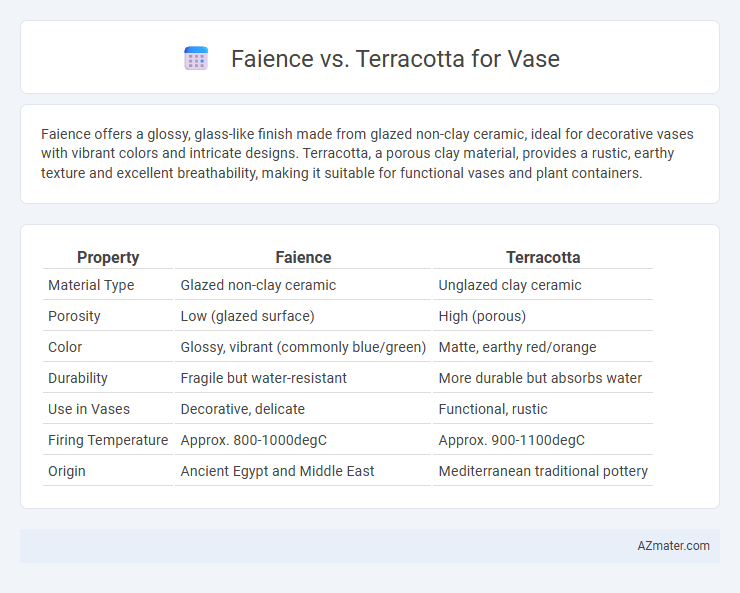Faience offers a glossy, glass-like finish made from glazed non-clay ceramic, ideal for decorative vases with vibrant colors and intricate designs. Terracotta, a porous clay material, provides a rustic, earthy texture and excellent breathability, making it suitable for functional vases and plant containers.
Table of Comparison
| Property | Faience | Terracotta |
|---|---|---|
| Material Type | Glazed non-clay ceramic | Unglazed clay ceramic |
| Porosity | Low (glazed surface) | High (porous) |
| Color | Glossy, vibrant (commonly blue/green) | Matte, earthy red/orange |
| Durability | Fragile but water-resistant | More durable but absorbs water |
| Use in Vases | Decorative, delicate | Functional, rustic |
| Firing Temperature | Approx. 800-1000degC | Approx. 900-1100degC |
| Origin | Ancient Egypt and Middle East | Mediterranean traditional pottery |
Introduction to Faience and Terracotta
Faience is a glazed non-clay ceramic material known for its bright, glossy finish and vibrant colors, often used in decorative vases prized for their intricate designs and durability. Terracotta, a porous earthenware clay fired at lower temperatures, is recognized for its natural, rustic appearance and earthy tones, making it ideal for traditional and handmade vases. Both materials offer distinct aesthetic and functional qualities that influence vase artistry and usage.
Historical Origins of Faience and Terracotta Vases
Faience vases originated in ancient Egypt around 4000 BCE, characterized by their glazed, brightly colored silica-based surfaces that symbolized fertility and rebirth. Terracotta vases date back to Neolithic times, widely used across ancient Mesopotamia and Greece for practical and ceremonial purposes, crafted from natural clay and fired to achieve durability. The distinct historical origins highlight faience's decorative and symbolic role versus terracotta's functional and artistic versatility in ancient societies.
Material Composition and Manufacturing Process
Faience vases are composed of glazed non-clay ceramic material made primarily from crushed quartz or sand, mixed with small amounts of lime and soda, and then fired at high temperatures to achieve a glossy, glass-like surface. Terracotta vases are crafted from natural clay rich in iron oxide, which is shaped and fired at lower temperatures, resulting in a porous, matte finish with a characteristic reddish-brown color. The manufacturing process of faience involves glazing before firing to produce vibrant colors and a smooth texture, whereas terracotta undergoes a simpler firing process without glaze, emphasizing natural earthy tones and porous structure.
Visual Differences: Color, Texture, and Finish
Faience vases exhibit a glazed, glass-like finish with vibrant colors typically in shades of blue, green, and turquoise, creating a smooth and glossy surface. Terracotta vases feature an unglazed, matte texture with earthy tones ranging from reddish-brown to orange, often revealing imperfections and a porous feel. The visual contrast lies in faience's polished, reflective quality versus terracotta's natural, rustic appearance.
Durability and Longevity of Vases
Faience vases, made from glazed ceramic material, offer superior durability due to their glass-like surface that resists moisture and wear, making them ideal for long-term display. Terracotta vases, crafted from natural clay, are more porous and prone to chipping and weathering, which can reduce their longevity when exposed to outdoor elements. For long-lasting use, faience vases maintain structural integrity and vibrant finishes better than terracotta counterparts.
Artistic and Decorative Versatility
Faience offers a glossy, vibrant finish with intricate glazing techniques that enhance color depth and surface sheen, making it ideal for elaborate artistic expressions and refined decorative details. Terracotta provides a warm, earthy texture with a matte finish, allowing for versatile sculptural forms and a rustic aesthetic that complements natural and traditional decor styles. Both materials support diverse artistic approaches, but faience excels in vivid color palettes and delicate ornamentation, while terracotta shines in textural richness and sculptural adaptability.
Cost Comparison: Affordability and Value
Faience vases typically cost more than terracotta due to their intricate glazing and firing process, which adds value through enhanced durability and aesthetic appeal. Terracotta is more affordable, favored for its natural, rustic charm and ease of production, making it an ideal choice for budget-conscious buyers. The value of faience lies in its glossy finish and historical significance, whereas terracotta offers practical longevity at a lower price point.
Ideal Uses for Faience Vases
Faience vases are ideal for decorative purposes due to their glazed surface, which provides vibrant colors and a glossy finish resistant to moisture and stains. Unlike terracotta, which is porous and best suited for plants and outdoor use, faience vases excel in indoor settings where aesthetic appeal and ease of cleaning are essential. Their durability against water damage makes them perfect for holding fresh flowers and enhancing interior decor with an elegant, polished look.
Suitable Applications for Terracotta Vases
Terracotta vases excel in outdoor garden settings and rustic home decor due to their porous nature, which allows air and moisture to pass through, supporting healthy plant roots. Their natural earthy tones and sturdy texture make them ideal for Mediterranean-style patios, balconies, and courtyard arrangements. Terracotta's durability under varying weather conditions also suits use in both decorative and functional planting containers.
Choosing the Right Vase: Faience or Terracotta?
Faience vases are glazed and fired with a glossy, colorful finish that offers durability and resistance to water, making them ideal for decorative indoor use. Terracotta vases, crafted from natural clay and unglazed or with a matte finish, provide a porous texture that allows better breathability for plants and is suitable for outdoor garden settings. Choosing between faience and terracotta vases hinges on the desired aesthetic, usage environment, and functional needs such as moisture retention and durability.

Infographic: Faience vs Terracotta for Vase
 azmater.com
azmater.com